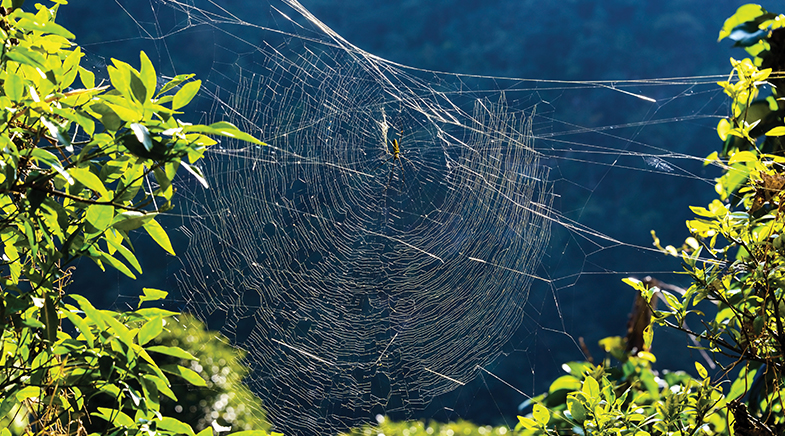Along came 1,774 spiders
-
- from Shaastra :: vol 01 issue 06 :: Nov - Dec 2022

Spiderman's secrets are out! A multi-institute study across five continents has put together the most comprehensive database yet on spider silk proteins. Researchers who studied 1,098 spider species have catalogued their silk gene sequences and identified 11,155 spidroin genes.
Spider silk is an example of an extended phenotype whose extraordinary mechanical properties are governed by the underlying composition and structure of protein-building blocks called spidroins. All genetic and protein data is directly connected to functional and mechanical data; the genetic and protein structures reveal properties such as tensile strength, elasticity, thickness and sheen of a particular kind of silk.
Spider silks frequently display a combination of high tensile strength, extensibility, and toughness that is unmatched industrially. "Understanding their structure, therefore, provides inspiration for protein biopolymer materials with low energy and high performance," the study says. The study provides a database that could be used to create biomaterial of the future — fabrics, plasters and medical material, for instance.
Unlike silkworms, which spin mainly to make cocoons, spiders make threads for a variety of functions such as foraging, locomotion, mating and nest-making. Since each purpose requires a fibre of a specific character, spider silks are greatly diverse. Orb-weaver spiders alone make seven types of threads, including the toughest ampullate or dragline silk.
"Spider silk, despite its amazingly diverse properties, uses only water as a solvent and there are no harsh chemicals involved. It does not need high heat or pressure to be created, and, after use, all of it returns to nature," says David Kaplan, Head of Biomedical Engineering, Tufts University, U.S., and one of the researchers associated with the project.
Their silk, however, has not been commercially exploited, for spiders are not easy to rear. Also, the silks are created for functions that are only possible when they are in the wild. Efforts have been made to manufacture recombinant spider silk (in labs), but the costs are high.
Dragline silk has garnered maximum industrial attention as it shows strength comparable to those of high-performance synthetic fibres. It also has a unique super contraction property and, when wet, can shrink by 60%. This is an undesirable industrial quality and it is important to understand the protein structures which cause super-contraction.
The fieldwork took place between 2014 and 2019 in nine countries, including India, where scientists from Indian Institute of Technology Guwahati were involved. The transcriptomes (mRNA sets) of 1,774 individual spiders were sequenced for the study. It reports sequences from 58 spider families which were not previously represented in public databases and identifies silk sequences from several non-web building spiders, which have received little scientific attention.
The researchers say that the Spider Silkome Database, which has open access, is the largest collection of data obtained to date, linking genotype to phenotype for a particular type of protein biopolymer.
"The aim of the study is not to manufacture spider silk, but to understand its diversity, and use its structure as a template for next generation material," Kaplan says.
Have a
story idea?
Tell us.
Do you have a recent research paper or an idea for a science/technology-themed article that you'd like to tell us about?
GET IN TOUCH














